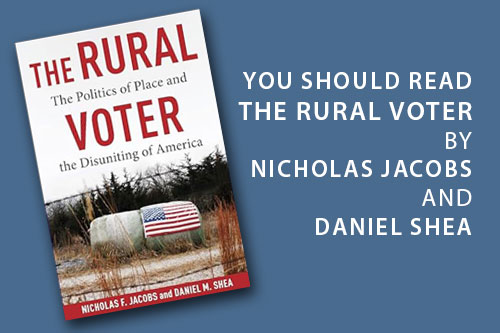I’d like to start the week off with what I’ll call…Data Day! (Cue the Monty Python illustrated montage, with majestic trumpets, ending in flatulence.)
Last week I mentioned that my read of the evidence is that Americans are right-leaning. This is an incredibly important question in strategy debates among Democrats. What drives many of us to heretofore unseen levels of profanity and exasperation with professional Democrats is the discrepancy between our poor electoral fortunes and the idea that we live in a Fifty-Fifty Nation. If the parties are at parity, why can’t the Democrats (frame/motivate our base/stay as united/enforce discipline/defend our principles) as well as Republicans? And the answers that lend themselves are that we have inept candidates, incompetent consultants, unprincipled elites, or ineffective framing.
It’s certainly true that we live in a Fifty-Fifty Nation when it comes to partisanship, even though that is an indicator of erosion in Democratic support since the post-Watergate ’70s. The following chart shows the Democrats’ share of party identification among adults who identify as either Democrats or Republicans (based on Gallup data I tabulated):

But the fact that the country is evenly divided in terms of partisanship doesn’t mean that it must be evenly divided in ideological identification. For that to be the case, liberalism would have to be as common among Democrats as conservatism is among Republicans. But it is not.
According to the 2004 American National Election Study, liberals were a majority among Democrats (56% versus 33% conservative). But conservatives dominate the Republican Party to a much greater extent, accounting for over 80 percent of their party members compared with just a 5% share for liberal Republicans. Nationally, there are 40 percent more conservatives than liberals. This was also true in 1972, the first year the NES asked respondents this question. In the Gallup data, where it’s impossible to allocate “leaning” moderates to the liberal and conservative groups, liberals look much scarcer.
The following chart is analogous to the previous one, except this time I show liberals as a share of those calling themselves either liberal or conservative. This chart is a bit disjointed because Gallup did not construct the ideology questions consistently from year to year. All of the data points listed were from questions providing at least three categories (liberal, moderate, or conservative), and most of them provide five. Question and category wording varied however, so I show each consistent series in the same color. Finally, I tried to be as consistent as possible in choosing the month in each year the survey was conducted.

I’ll stop here and let you all comment on the questions all these data raise. How meaningful are the labels “liberal” and “conservative”? How can we account for the timing of the changes in the data? If self-identified ideology is meaningful, what are the implications for various electoral strategies prescribed for Democrats?
The Daily Strategist
Welcome to The Daily Strategist, the blog of our new magazine. I’m Scott Winship, managing editor of The Democratic Strategist and blogger-in-chief. I will typically be posting once a day in the late evening. Why only once a day you ask? Well, in addition to running the magazine, I am (in theory) writing a dissertation in social policy. I’m also involved in a couple of other outside projects which you can easily find if you google me and have too much time on your hands. Which you don’t because you haven’t read the whole premiere issue yet, have you?
In The Daily Strategist — I lobbied to call it The Strat-o-caster but wiser heads prevailed — I hope to augment the monthly publication cycle of the magazine with information relevant to Democratic national political strategy. Some days that will mean highlighting news from other outlets. Other days it will mean provoking other bloggers or responding to their provocations. Still other days I will summarize academic and think tank research. And Fridays I will likely make unconvincing attempts to pass off reviews of VH1’s evening schedule as relevant to political strategy.
In a very real way, you (dear reader) can help make this a better blog by passing along links to articles or studies that I can deconstruct. I know that sounds like I’m pushing my work off on you, but hey, Josh Marshall does it so why can’t I? (Incidentally, if anyone out there knows Stata, I’d love to push my dissertation work off onto you too. And if you live in D.C., let me know if you’re interested in doing my laundry.)
Before I sign off, you deserve to know a bit about my own ideological predispositions. First and foremost, I am an empiricist, so I try to the extent possible to rely on evidence, data. My read of 20th-century American political history and the analysis I’ve done of electoral data lead me to believe that, unfortunately, there are not enough voters out there who are as secular or fiscally progressive as I am. And there are not enough who are as anti-nationalist as many of you are. As such, I am of the view that Democrats must make (modest) efforts to accomodate those who are to the right of progressives.
At the same time, I part ways with most progressives in a number of policy and political debates. I am essentially a chastened Peter Beinart hawk. I believe in a social policy that both promotes opportunity but demands responsibility. I’m sympathetic toward market-based policies. The point is, in some regards I have a real affinity for moderate Democrats rather than simply being pragmatic.
Can I win you back if I say that in my perfect world we’d have universal health care, a higher minimum wage, gay marriage, more progressive taxes, no creationism in schools, more generous family leave, more legal immigration, preschool for all, tougher fair housing laws, and – uh – polar ice caps?
Stripped of blind ideology, policy — and political strategy — is complicated. The trick is to always treat one’s views as provisional, grapple with evidence, and let the chips fall where they may. We all have to be prepared to say we were wrong, myself included. I’d like to think that’s the spirit that will guide The Democratic Strategist as we collectively search for the keys to building an enduring Democratic majority.
Talk to you Monday!








